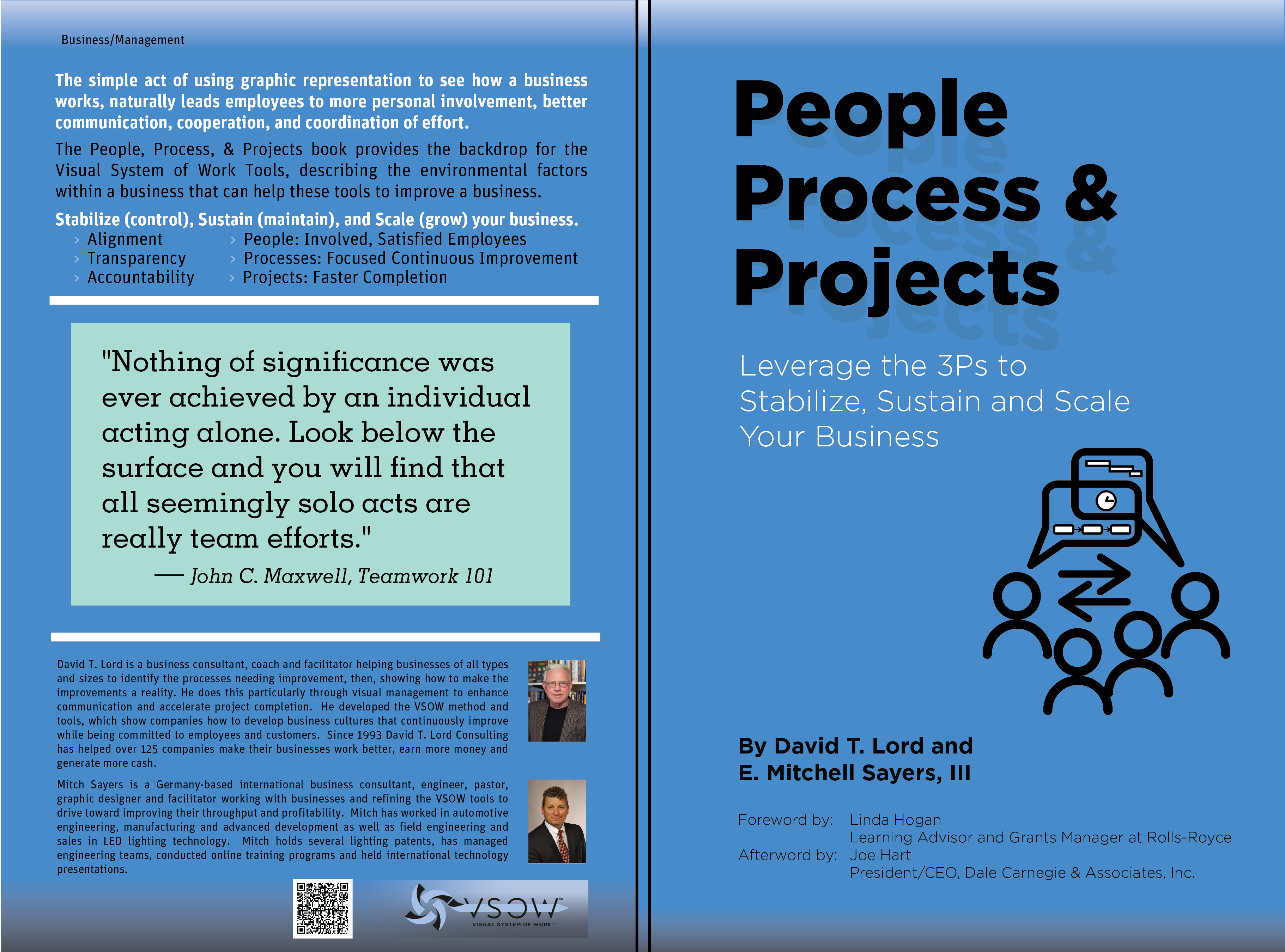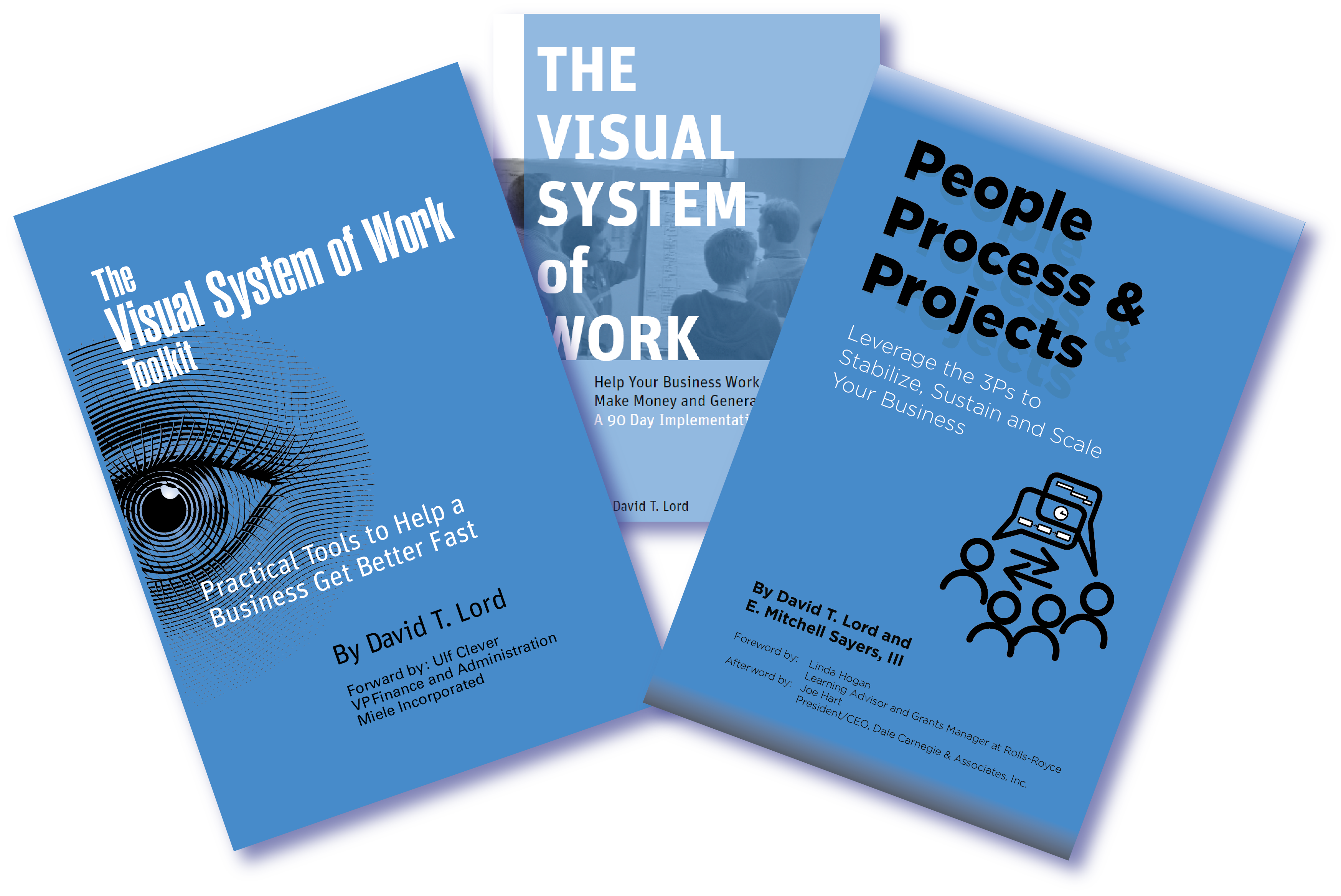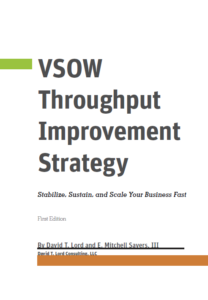VSOW Books
Read more about VSOW
New Release

People, Processes, and Projects – Leverage the 3Ps to Stabilize, Sustain, and Scale Your Business gives a backdrop to the Visual System of WorkTM (VSOWTM), underscoring respect for people, and the impact of VSOW – getting better fast, making money, and generating cash. It lays out the elements required to create an environment where people love to come to work and where business owners can step out from under the clouds of difficulty, uncertainty, and frustration into the sunlight of hope.
The VSOW Mission (introduced in the Visual System of Work Toolkit book) and its important aspects are reviewed — participation, work environment, and shared success – as well as how these are aided with the VSOW guiding principles. Environment, Time, and Resource Domains, with their development, principles, and examples give a framework and context for improvement within a business. Each of the VSOW Tools (outlined in detail in the Visual System of Work Toolkit book) is given context within the domains to make them easier to apply.
An important aspect of environment is transparency, and an important aspect of transparency includes the Break-Even Point in a business – “The Beginning of Winning.” This is examined further in Chapter Two, explaining its use in positioning the business within the Time Domain: in which state is the business right now? This and other methods to foster transparency are examined in the chapter including concepts used by the Great Game of Business.
Engaging Your People is explained from its development and through the use of VSOW Tool 2 – The Three Questions. Engagement examples and inspiration from literature on quality improvement take the concept of focus on people in a business further.
Looking at processes, Larry Moore and his interaction with Dr. Deming gives insight into elements which helped Whirlpool and Miele to manage their processes by making them visible.
Projects are examined in Chapter Five by following the development and use of the Project Planning Sheet (5W2H) and its application.
In the Changing States chapter, the Time Domain is examined with respect to the states of Stabilizing, Sustaining, and Scaling in a business using a graphical depiction to introduce Control Zones. These zones help businesses learn the importance of each stage; progression from Stabilizing to Sustaining must occur before Scaling the business. The Environment for the various States is examined to help determine where focus should be placed in each state.
This all serves as the foundation to understand the implementation of the VSOW Tools better, making it a powerful compliment to The Visual System of Work Toolkit book. Employees will discover how to run the business better, make more money, and generate cash, sharing in the success of the business from a personal and professional perspective.
The VSOW Books

The first book, The Visual System of WorkTM, was released in 2013 in order to tie together the method and tools that David Lord had used in practice over the course of 20 years. This method worked. The book combines the importance of making the core values and the operation of a business visible to its employees – you cannot manage what you cannot see. It also emphasized the importance of small businesses and the challenges they face. Out of these comes the book’s main focus: making money and generating cash. The Visual System of Work is designed to develop trust among the employees of the business at all levels, thereby transforming the business from a reactive to creative workplace. This is achieved through the use of Storyboards, a Control Room, and the use of specific tools. One of the most meaningful tools is the Throughput Improvement Plan, consisting of seven steps to remove bottlenecks in the money-making processes of the business. Finally, The Visual System of Work made a Call to Action: Implement a simple method with tools to start something new and bring growth into your business, by engaging people – the most valuable asset of the business – to work better and generate more cash. There are no limits.
The next book, The Visual System of Work ToolkitTM begins with the Mission and Guiding Principles of the Visual System of Work (now referred to as VSOW), and underscoring the importance of making work visible. Then the twelve tools of the toolkit are introduced with their Job To Be Done (JTBD) and Context of Use with the use of icons to easily recognize them in the Flow of the Tools Diagram that demonstrates how the tools can be employed in sequence. Each tool is described by real-world users (business owners and managers), including their experiences, insights, and the benefits they received. Additionally, Mitch Sayers entered the picture to contribute to the detailed description of use and pictoral usage aids for each tool as well as an engineering-style synthesis of the tools (Flow of the Tools). Frequent references will be made in this book (Leveraging the 3Ps) to certain tools mentioned in the other books, making the VSOW Toolkit book a real reference guide.
The Leveraging the 3P’s delves into the philosophy behind the VSOW – the essence of what is truly important for it to work. It describes the journey from struggling to flourishing. The foundation of the VSOW – respect for people – is described in detail
and context. It describes the impact of VSOW – getting better fast, making money and generating cash – and having fun while doing it. This all works to the purpose of giving a business owner hope that there is an effective way to make the business
better while creating an environment where people love to come to work. Leveraging the 3P’s describes three significant domains (or dimensions):
1. The operating environment of the VSOW method – what is surrounding the tools to help make them work: Alignment, Transparency, and Accountability (ATA).
2. What results can be expected – the three states of business: Stability, Sustaining, and Scaling (the 3S’s), and how leadership works to facilitate from one state to another.
3. How the precious resources of the 3Ps – People, Processes and Projects – are used to produce change in a business. These domains form the foundation for the VSOW method and could be viewed as the ecosystem within which the VSOW tools are used.
 After this comes the book, Throughput Improvement Strategy (TIS)TM. This delves in more detail into the aspects of Throughput Accounting, the Break-Even Point and the use of the Throughput Improvement Plan to remove interferences (bottlenecks) in business operations to increase throughput in the business, producing rapid improvement. Examples of these aspects are provided to help business owners relate them to their businesses.
After this comes the book, Throughput Improvement Strategy (TIS)TM. This delves in more detail into the aspects of Throughput Accounting, the Break-Even Point and the use of the Throughput Improvement Plan to remove interferences (bottlenecks) in business operations to increase throughput in the business, producing rapid improvement. Examples of these aspects are provided to help business owners relate them to their businesses.
These books together provide a comprehensive view of the Visual System of Work for business owners to take and apply to their operations. This application is greatly eased with facilitation to guide the process, observing conditions and improvements and applying the right tools at the right time in the right way.
These are all supported with the VSOW Academy, an online learning system to assist business owners and their teams to get up to speed quickly and accelerate the facilitated process of implementing the Visual System of Work.
Learn more about the Visual System of WorkTM and how it can work for your business.
Make VSOW Work for Your Business
See who is behind VSOW and set up a time to meet.
Reach Us
We would like to hear from you!
support@vsow.business
